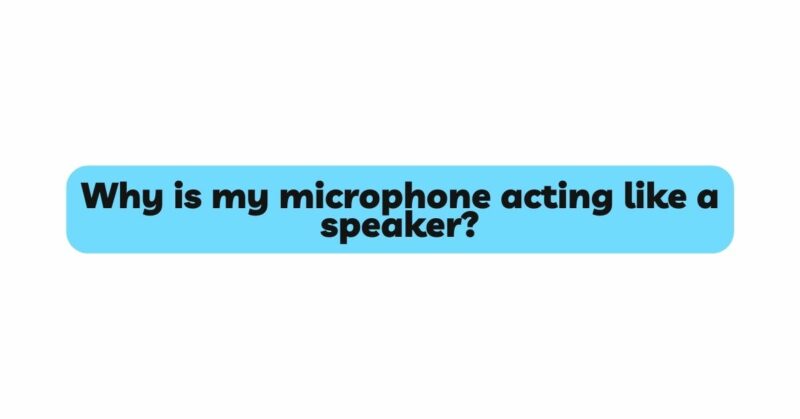In the realm of modern audio technology, microphones and speakers are integral components that enable effective communication, entertainment, and content creation. However, encountering an unexpected and puzzling scenario where your microphone seems to behave like a speaker can be quite bewildering. The phenomenon of your microphone producing sound output, similar to a speaker, can leave you scratching your head. In this article, we delve into the underlying reasons behind why your microphone might inexplicably act like a speaker and explore potential solutions to address this enigmatic occurrence.
1. Microphones and Speakers: Understanding the Basics
Before diving into the causes of microphones acting like speakers, it’s essential to grasp the fundamental differences between these two audio devices. Microphones are designed to capture sound waves and convert them into electrical signals, which can then be processed or recorded. On the other hand, speakers work in the opposite direction by receiving electrical signals and transforming them into audible sound. These distinct functions and mechanisms form the backbone of audio transmission and reproduction.
2. The Feedback Loop Enigma
One of the primary culprits behind microphones acting like speakers is the phenomenon known as the “feedback loop.” This occurs when sound output from a device, such as a computer’s speakers, is inadvertently captured by the microphone and then re-amplified, creating a continuous loop of audio playback. Feedback loops can arise due to various factors, including improper settings, audio routing, and acoustic conditions.
3. Improper Audio Routing and Configuration
Misconfigured audio settings and routing within your computer or audio interface can lead to the unexpected behavior of your microphone acting like a speaker. Some systems allow audio output to be directed to input sources, including microphones. If this happens, the sound meant for playback through speakers can end up being routed to the microphone input, initiating a feedback loop.
4. Acoustic Environment and Reflections
The physical environment in which you’re operating can contribute significantly to the microphone acting like a speaker. Echoes and reflections of sound waves can bounce around hard surfaces, reach the microphone, and subsequently be re-amplified. Rooms with surfaces that reflect sound can inadvertently create a feedback loop where audio continuously cycles between the microphone and speakers.
5. Software and Communication Platforms
Certain software applications and communication platforms can inadvertently contribute to the microphone acting like a speaker. Video conferencing or voice chat applications may have settings that unintentionally route audio from the microphone back through the speakers. Enabling these settings can trigger a feedback loop, causing the microphone to behave like a speaker.
6. Audio Drivers and System Updates
Outdated or incompatible audio drivers can introduce unexpected audio behavior, including the microphone acting like a speaker. System updates, changes in operating systems, or driver updates can alter default audio settings, leading to feedback loops. Ensuring that your audio drivers are up to date and compatible with your system can mitigate this issue.
7. Noise Cancellation and Echo Suppression
Advanced audio features like noise cancellation and echo suppression, designed to enhance audio quality during communication, can ironically contribute to the microphone acting like a speaker. Improperly configured noise cancellation settings may inadvertently amplify certain frequencies, causing a feedback loop.
8. Hardware and Physical Solutions
Practical hardware solutions can help prevent your microphone from behaving like a speaker. Utilizing headphones instead of external speakers can effectively break the loop, as headphones prevent audio output from being captured by the microphone. Placing physical barriers, such as acoustic panels or isolation mounts, between the microphone and speakers can reduce sound reflections and mitigate the likelihood of feedback.
9. Expert Assistance and Troubleshooting
If the issue persists despite your efforts, seeking expert assistance or referring to troubleshooting guides specific to your hardware and software can be valuable. Online forums, community support, and reaching out to technical support for your devices or applications can provide tailored insights and solutions.
Conclusion
The perplexing occurrence of your microphone behaving like a speaker can be demystified by examining factors such as feedback loops, audio settings, acoustic conditions, software configurations, and the dynamics of audio transmission. By delving into the interplay between microphones and speakers, you can effectively address and resolve this unusual behavior. Armed with knowledge and practical solutions, you can prevent your microphone from unexpectedly doubling as a speaker, ensuring that your audio experiences remain seamless, uninterrupted, and devoid of perplexing anomalies. As technology continues to evolve, mastering the intricacies of audio devices becomes increasingly essential for harnessing their full potential and delivering exceptional sound quality.


